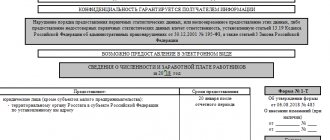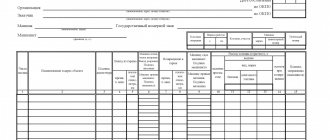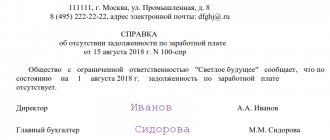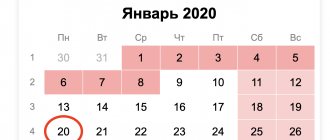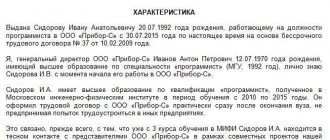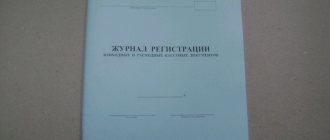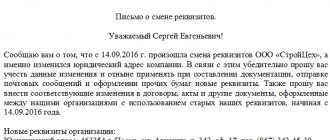The cashier-operator must draw up a document that accompanies the closing of the cash register after the shift. This document is called a cashier's certificate report . The document contains the necessary information about the meter data, specific amounts associated with collection, and any other data with which you can track the movement of cash. The document also indicates the closing date of the shift. If the senior cashier used several cash registers, then it is necessary to prepare a summary report that will contain information from the KM-7 form document. Now we will look at the rules for drawing up this document. You can at the end of this article.
The KM-7 form must be filled out in one copy. It must be submitted to the accounting department before the cash day begins, as well as other reports, such as receipts, return statements and other documents. The sample can be downloaded here.
KND form 1110021 is filled out if there is a need to open, re-register or deregister a cash register.
Who should use forms KM-7 and KM-6
Form KM-7 is a document that is directly related to the use of a cash register system that has an ECLZ. The obligation to use it has been abolished since July 2020 with amendments to the Law “On the Application of CCP” dated May 22, 2003 No. 54-FZ. And from July 2020, this form becomes completely unnecessary due to the cessation of the use of cash desks equipped with ECLZ. However, this does not prevent the continued use of the KM-7 form only insofar as it concerns information about the amount of revenue received per shift.
Read about what equipment has replaced cash registers with EKLZ in the article “Procedure for switching to online cash registers since 2016” .
At the time of the use of cash registers equipped with EKLZ, the KM-7 form was a mandatory attachment to another unified form - KM-6, which the cashier-operator had to draw up. But with the introduction of amendments to the law “On the Application of Cash Register Machines”, form KM-6 is filled out only at the request of the business entity.
See here for details.
The report on form KM-7 contains columns for indicating the factory and registration numbers of all used cash registers. Moreover, it was required to create it for any number of available cash registers, including for a single cash register.
The KM-7 form was approved by Decree of the State Statistics Committee of the Russian Federation dated December 25, 1998 No. 132. You can download it on our website.
The procedure for filling out the KM-7 form
Filling out information about meter readings is carried out on the basis of ready-made report forms for cashiers-operators. Form KM-7 is attached to cash reports.
Instructions for filling:
- details of the organization, owner of the cash register are filled in;
- the name of the department is indicated;
- the number is entered, as well as the date of registration accurate to the minute;
- in the “attachment to cash reports” field, all cash reports for which the combined KM-7 form is prepared should be listed;
- information about the serial and registration number of the cash register is filled in in the table;
- Next, the KKM counter readings are entered at the beginning and end of the shift;
- followed by the total revenue for the day, divided by department and in total;
- cashiers’ signatures are placed opposite the amount of revenue;
- The amount returned to the buyers under the act is separately noted.
The completed sample information about meter readings, form KM-7, must be signed by the following persons:
- senior cashier;
- Head of the organization.
The information is attached to the KM-6 report.
Information about KKM meter readings can be filled out using computer programs, in which case filling out the report is simplified. In addition to the KM-7 form, the cashier must fill out the KM-4 cashier-operator logbook every day.
blandoc.ru
What are the features of filling out a report on form KM-7
Form KM-7 had to be generated daily in 1 copy and submitted to the accounting department before the start of the next work shift together:
- with form KM-6;
- PKO, RKO;
- acts in the KM-3 form (for the return of funds to customers).
The table, which is the main element of the KM-7 form, indicated and summarized the indicators for all fiscal counters of cash register systems, as well as for cash revenue for the trading entity as a whole or broken down by department (in this case, the figures were certified by the signatures of the heads of the relevant departments).
The amounts reflected in the acts in the KM-3 form, that is, returned to the company’s buyers, were indicated in words in a special column located under the table.
The information recorded in the KM-7 form was certified by the head of the trading entity, as well as by the senior cashier.
Read about the KUM-3 form in the material “Unified form No. KM-3 - form and sample” .
Purpose of the document
A report in the standard form KM-7 is compiled daily by a business organization that has two or more operating cash register devices.
If a company that accepts cash from customers uses only one cash register device, its cashier should prepare not a KM-7, but a cashier-operator’s certificate report.
In addition, in an organization that uses cash registers, the cashier-operator log is filled out daily (standard form KM-4).
The unified form used to fill out the KM-7 reporting form was regulated by the State Statistics Committee of the Russian Federation back in 1998 (No. 132). KM-7 supplements the report of the cashier-operator, compiled according to the standardized form KM-6.
The responsible cashier of the business entity transfers both KM-6 and KM-7 to the accounting department. These reports are supported by the relevant cash documents - RKO/PKO.
Who applies and when?
Using KM-7, readings from all cash register devices of the organization are recorded daily. This report is not unreasonably considered one of the primary documents of a business entity that accepts cash.
KM-7 reporting is maintained (compiled) daily by the chief cashier of the business entity. Documentary grounds for compiling KM-7 - completed KM-6 reports.
The necessary information is entered daily into the appropriate fields of the KM-7 form after the generation of Z-reports (by the end of the next operating day).
Regulatory requirements provide for the mandatory transfer of all cash reports to the accounting department no later than the next business day.
The requirement to manually fill out KM-7 is not considered mandatory.
It is important that this report be printed on two sides of one sheet and certified by the signatures of the responsible entities - employees of the organization.
Based on the results of one operating day, for any number of cash register devices used by the enterprise, only one report should be filled out, compiled according to the KM-7 form.
In order not to get confused in cash documentation, it is recommended to prepare separate KM-7 forms for both the main business entity and its separate divisions.
How to fill out information about KKM meter readings and revenue?
As mentioned earlier, the daily reporting form according to the standard KM-7 form is filled out on the basis of actual information recorded by the responsible cashiers in KM-6.
Every day, summary information is entered into the documentary form KM-7 about the control readings of the counters of cash register equipment and information about the revenue received in each of the divisions of the organization.
The header of this cash report is characterized by a typical data structure - it contains the following information:
- name of the business entity (organization), its official address, contact telephone number;
- a set of standard details - registration codes (OKVED, INN, OKPO, OKUD);
- the name of a specific structural unit related to the business entity (if necessary);
- the serial number of the document being filled out, assigned to a specific form according to the principle of continuous numbering;
- the current date and exact time of compiling the report (taken from the Z-report information);
- dates/numbers of specific reports of the cashier-operator, supplemented by the compiled form KM-7.
The tabular part records information about the control readings of each cash register device, as well as cash revenue received and accounted for by cash register devices for a specific working day. Accordingly, it contains the following information:
- The number of a specific cash register. The business entity independently assigns this number to its own cash register.
- The number of a specific cash register device (it can be found in the factory, technical documentation attached to the cash register device).
- Registration number of the cash register machine (assigned by the tax service when a specific device is officially registered).
- The number of the generated CCP Z-report, the information of which was used when filling out the cash reporting form.
- Information from the control counter (the appropriateness of filling out this column is questionable).
- Information from the cash counter of the cash register machine at the beginning of the operating day (shift).
- Information from the cash counter of the cash register equipment at the end of the operating day (shift).
- The amount of daily revenue (according to the meter).
- From column 9 (ninth) to column 14 (fourteen), the amount of daily revenue is broken down by division (department) of the business entity.
- At the bottom of the table form, the total values of daily revenue are calculated - for the company as a whole, as well as broken down by individual divisions of the business entity.
- The amount of cash returned to customers on previously issued checks is also written down in a separate line located at the bottom of the form (according to the act).
The head of the business entity and its chief cashier sign the completed form. The summary nature of KM-7 suggests that an organization using a single cash register device does not fill out this report.
and sample filling
Form KM-7 –
A sample of filling out information about KKM meter readings and the organization’s revenue -
How to fill out the form
To fill out the KM-3 form, the participation of a commission of employees is necessary, and not just the cashier-operator himself, who cannot make such a decision arbitrarily. As a rule, a representative of the store administration and/or a senior cashier is present (as well as an administrator, shift manager, etc. - depending on the internal rules of the company).
The procedure is as follows:
- The possibility of a refund for a product or unused service is assessed (for example, medicines, home textiles cannot be returned).
- If a positive decision is made, the buyer draws up an application, the cashier – an explanatory note (if necessary).
- A full settlement is made with the buyer, for which he is given a refund check.
- On the same day, the KM-3 form is printed and filled out. All responsible persons sign.
- The document is sent for storage to the accounting department.
NOTE. The act must be certified by the signature of the director (or the person acting as him). After this, a stamp is affixed and the act is stored in the accounting department for at least 5 years.
The act does not have to be sent to the tax office for verification. However, it is shown at the first request of the inspector (or sent to the tax office if it requests confirmation).
Share link:
Application of the KM-7 form
In cases where an organization operates several cash registers at once, then a unified form KM-7 . This form helps to compile a consolidated report on information about the income of a legal entity from all cash registers used. Moreover, the report is drawn up for the current day of the organization’s work.
The senior cashier prepares one copy of the KM-7 form and, together with other reporting documents, sends it to the accounting department at the end of the work shift. Form KM-7 indicates information for each cash register at the beginning of the work shift and at its end. The amount of revenue is certified by the signature of the head of each department.
The organization's total revenue is entered in a special field on the KM-7 form. The information specified in the document makes it possible to evaluate the efficiency of the enterprise. The distribution of funds among departments of the organization also occurs based on the daily reporting table. Indications from cash registers must be signed by the senior cashier, as well as the head of the organization.
Sample and example of an act 2020 - 2018
The document has a single approved form and is used in all stores, service points and other organizations involved in retail trade. It must contain the following information:
- Official full name of the organization and contact details, type of activity and TIN.
- Name of the cash register and application program.
- Act number (in accordance with the numbering adopted by the company) and the date of its preparation.
- “I approve” visa for the manager (store director).
- The tabular part, which lists in chronological order the numbers of checks punched incorrectly (or checks for which funds must be returned), the amount is written down to the nearest penny and the full name and position of the person who authorized the return of money is indicated (for example, a senior cashier or administrator ).
- Next, the total amount of all returned funds and/or the amount of all erroneously punched checks is indicated in words. It is prescribed that all cash receipts on a given day should be reduced by this amount.
- Next, all members of the commission who participated in drawing up the act sign – usually this is the department manager, the senior cashier and the cashier himself who made the mistake (or returned the funds to the buyer). The official title of the position is written down, a signature is placed and a transcript (last name, initials).
In the same act, it is allowed to record both returned and erroneously punched checks. But they all must have the same date. Therefore, if such operations are performed on different days, a separate form is drawn up for each day.
The form is presented below:
Completed form that can be used as a sample:
Legal regulation
Since 2013, documentation forms approved by the State Statistics Committee of Russia have ceased to be mandatory. However, the Ministry of Finance, having disseminated the relevant information, excluded cash documents from the list of such documentation.
It follows from this that the KM-7 certificate form approved by Resolution No. 132 also does not apply to the legislation on cash registers and, accordingly, is not mandatory for use on the territory of Russia.
At the same time, it is important to remember that summary information about the data of cash register meters and revenues themselves are included in the list of documentation that may be requested by the tax authority as part of the performance of the state function of monitoring the use of cash register machines (clause 2 of article 5 of the Federal Law dated 05/22/2003 N 54-FZ, paragraph "l" clause 29 of the Administrative Regulations, approved by Order of the Ministry of Finance of the Russian Federation dated October 17, 2011 N 133n, paragraph "z" clause 34 of the Administrative Regulations, approved by Order of the Ministry of Finance of the Russian Federation dated 17.10. 2011 No. 132n).

